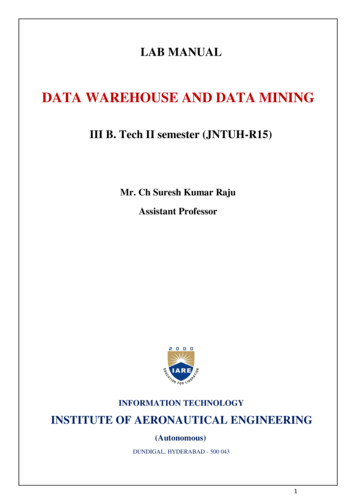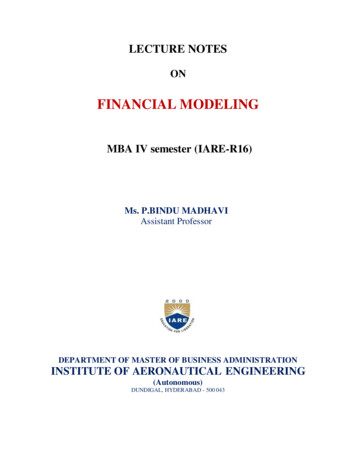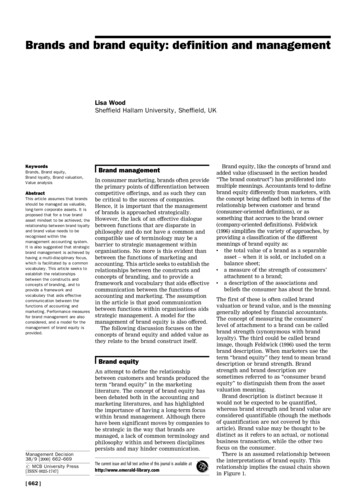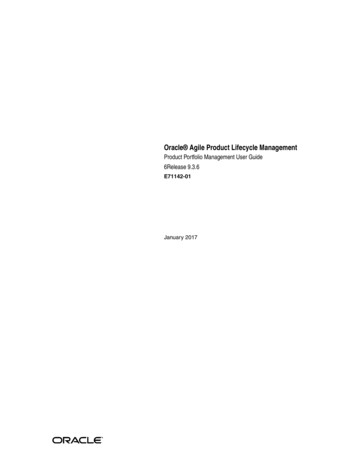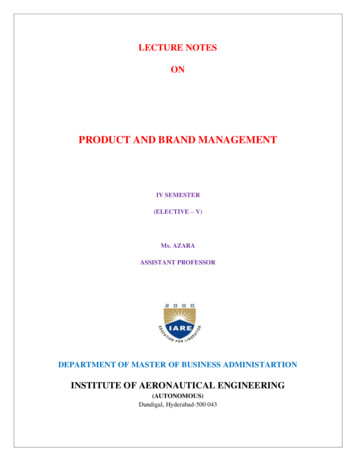
Transcription
LECTURE NOTESONPRODUCT AND BRAND MANAGEMENTIV SEMESTER(ELECTIVE – V)Ms. AZARAASSISTANT PROFESSORDEPARTMENT OF MASTER OF BUSINESS ADMINISTARTIONINSTITUTE OF AERONAUTICAL ENGINEERING(AUTONOMOUS)Dundigal, Hyderabad-500 043
UNIT-1PRODUCT CONCEPTSDEFINITION OF 'PRODUCT'Definition: A product is the item offered for sale. A product can be a service or an item. It can be physical or invirtual or cyber form. Every product is made at a cost and each is sold at a price. The price that can be chargeddepends on the market, the quality, the marketing and the segment that is targeted. Each product has a useful lifeafter which it needs replacement, and a life cycle after which it has to be re-invented. In FMCG parlance, a brandcan be revamped, re-launched or extended to make it more relevant to the segment and times, often keeping theproduct almost the same.Description: A product needs to be relevant: the users must have an immediate use for it. A product needs to befunctionally able to do what it is supposed to, and do it with a good quality.A product needs to be communicated: Users and potential users must know why they need to use it, what benefitsthey can derive from it, and what it does difference it does to their lives. Advertising and 'brand building' best dothis.A product needs a name: a name that people remember and relate to. A product with a name becomes a brand. Ithelps it stand out from the clutter of products and names.A product should be adaptable: with trends, time and change in segments, the product should lend itself toadaptation to make it more relevant and maintain its revenue stream.PRODUCT MIXproduct mix, also known as product assortment, refers to the total number of product lines that a company offersto its customers. For example, a small company may sell multiple lines of products. Sometimes, these productlines are fairly similar, such as dish washing liquid and bar soap, which are used for cleaning and use similartechnologies. Other times, the product lines are vastly different, such as diapers and razors. The four dimensionsto a company's product mix include width, length, depth and consistency.
WIDTHThe width of a company's product mix pertains to the number of product lines that a company sells. For example,if a company has two product lines, its product mix width is two. Small and upstart businesses will usually nothave a wide product mix. It is more practical to start with some basic products and build market share. Later on, acompany's technology may allow the company to diversify into other industries and build the width of the productmix.LENGTHProduct mix length pertains to the number of total products or items in a company's product mix, according toPhilip Kotler's textbook "Marketing Management: Analysis, Planning, Implementation and Control." Forexample, ABC company may have two product lines, and five brands within each product line. Thus, ABC'sproduct mix length would be 10. Companies that have multiple product lines will sometimes keep track of theiraverage length per product line. In the above case, the average length of an ABC Company's product line is five.DEPTHDepth of a product mix pertains to the total number of variations for each product. Variations can include size,flavor and any other distinguishing characteristic. For example, if a company sells three sizes and two flavors oftoothpaste, that particular brand of toothpaste has a depth of six. Just like length, companies sometimes report theaverage depth of their product lines; or the depth of a specific product line.CONSISTENCYProduct mix consistency pertains to how closely related product lines are to one another--in terms of use,production and distribution. A company's product mix may be consistent in distribution but vastly different in use.For example, a small company may sell its health bars and health magazine in retail stores. However, one productis edible and the other is not. The production consistency of these products would vary as well.PRODUCT MARKET MIX STRATEGYSmall companies usually start out with a product mix limited in width, depth and length; and have a high level ofconsistency. However, over time, the company may want to differentiate products or acquire new ones to enternew markets. A company can also sell the existing products to new markets by coming up with new uses for theirproduct.
PRODUCT LINEThe product line is a subset of the product mix. The product line generally refers to a type of product within anorganization. As the organization can have a number of different types of products, it will have similar number ofproduct lines. Thus, in Nestle, there are milk based products like milkmaid, Food products like Maggi, chocolateproducts like Kitkat and other such product lines. Thus, Nestle’s product mix will be a combination of the all theproduct lines within the company.PRODUCT LINE LENGTHIf a company has 4 product lines, and 10 products within the product line, than the length of the product mix is 40.Thus, the total number of products against the total number of product lines forms the length of the product mix.This equation is also known as product line length.PRODUCT LINE WIDTHThe width of the product mix is equal to the number of product lines within a company. Thus, taking the aboveexample, if there are 4 product lines within the company, and 10 products within each product line, than theproduct line width is 4 only. Thus, product line width is a depiction of the number of product lines which acompany has.PRODUCT LINE DEPTHIt is fairly easy to understand what depth of the product mix will mean. Where length and width were a functionof the number of product lines, the depth of the product mix is the total number of products within a product line.
Thus if a company has 4 product lines and 10 products in each product line, than the product mix depth is 10. Itcan have any variations within the product for form the product line depth.PRODUCT LINE CONSISTENCYThe lesser the variations between the products, the more is the product line consistency. For example, Amul hasvarious product lines which are all dairy related. So that product mix consistency is high. But Samsung as acompany has many product lines which are completely independent of each other. Like Air conditioners,televisions, smart phones, home appliances, so on and so forth. Thus the product mix consistency is low inSamsung.PACKAGINGPackaging is the activity of designing and producing the container or wrapper for the product. It is an importantand effective sales tool for encouraging the consumers for buying. It is powerful medium for sales promotion. Itmust perform all the basic function such as protection, ease of handling and storage, convenience in usage etc. andshould not be deceptive and convey any deceptive message. It is the best method for attracting the consumers forbuying the products.According to W.J.Stanton, “Packaging may be defined as the general group of activities in product planningwhich helps in value designing and producing the container or wrapper for a product.”According to Pride and Farell, “Packaging involves the development of container and a graphic design for aproduct.”FUNCTIONS OF PACKAGINGPackaging should serve the following basic functions:
Protects the contents:The basic function of packaging is to protect the contents from damage, dust, dirt, leakage, pilferage, evaporation,watering, contamination and so on. Packaging helps in the protection of the contents of the products. Seasonalfluctuations in demand may be smoothed out through packaging. Packaging helps to protect the contents of all theavailable products. Provides product density:Packaging helps to provide product density. It implies selecting such package materials, design, and shape thathelps to use the limited space in the best way. It improves relations with common carriers, permits better use ofspace in storage and usage and increases the grace and poise of arrangement. Act as promotional tool:Good packaging can sell the product more easily and quickly as it works as a promotional tool. As a promotionaltool, it does self-advertising , displaying, publishing and acts as an advertising medium. It is the package, size,design, color combinations and graphics that decide its ability to attract the valuable attention of customers or theprospects. Provides user convenience:Packaging helps to provide the user convenience.The good packaging does this in a greater degree. As a result,the marketing functions of the transportation, storage, and handling are performed with ease and without wastage.Consumers are greatly assisted so long as the product is in usage. Neat packaging has brought a home reduction ininventory costs, packaging costs, space and time costs. Facilitates product identification:Packaging helps to facilitate the identification of the product. This process of product differentiation is furtheredby effective product identifiers; one is branding and another is packaging. The product package identifies theproduct no matter where you see it, under what circumstances you see it, or when you see it. A package is
product’s personality, its reality. Product identification goes easy with distinguished packaging as it adds to itspersonality or image. Allows easy product mix:Product mix relates to the product lines and an assortment of sizes, colors, measures, grades, package types etc.offered by the selling house. Change in product mix can be possible as packaging helps to influence weight, size,and dimensions of the product. Packaging helps to allow the product mix easily for the consumers.IMPORTANCE OF PACKAGINGThe importance of packaging are as follows: Creation of demand:Packaging plays an important role in the creation of demand by attracting the consumers. The customers becomeknown with the product through advertising. It helps to increase the demand of the customers. Protection of the product:Packaging helps to protect the product from heat, light, moisture, evaporation, dust etc. during its long passagefrom the factory to the target customers. It protects the products from breakage, leakage spoilage etc. Transportation:Packaging facilitates transportation of products from one place to another. It ensures easy transportation and betterhandling of products in transit. Guidelines to customers:Packaging helps as a guidelines for the customers. From the informative literature regarding the quality and use ofthe product, the customers get the guidelines. The customers are ensured about the quality of the products. Better storage:Packaging acts as a better storage of the products. Goods with good packages can be stored in the retail shop alsoin lesser price. Facilitates for carrying:Packaging plays an important role in carrying the goods in transit and from one place to another. It is made indifferent sizes and it facilitates provisions for easy and open carrying. Identification of product differentiation:Packaging helps to identify the product differentiation easily. It ensures the individuality of the products and oneproduct can be easily differentiated with each other products in the market. The customers can easily identify their
product of choice at the time of purchase. This helps the customers to prevent substitution of goods by othercustomers. Economy:Packaging helps to reduce the cost of marketing the goods by reducing losses from damages. As packaging ishelpful for sales promotion, so it helps to attain economy in the cost structure of the producers and marketers.Types of packagingThere are various types of packaging some of them are as follow: Consumer packaging:Consumer packaging is one which holds the required volume of a product for ultimate consumption. It is themeans of buying household. In other words, the consumer has the option to purchase the pack size which he/sheconsiders adequate for the consumption of his/ her family over a length of time. Transit packaging:Transit packaging is another type of packaging. It is either for the industrial consumer’s use. The consumerpackage itself very often requires an outside package in which it is sometimes referred to a bulk package or anouter container. Industrial packaging:An industrial packaging can either describe a bulk package or the package for durable consumer goods. These arethe basic package types although many subdivisions can be listed which can be broadly listed under these basicheadings. Dual use packaging:A dual packaging is one which has a secondary usefulness after its contents have been consumed. The examplesof dual use packaging are Drinking glasses, boxes of jewelry, waste baskets, refrigerator dishes, etc.
Features of good packagingA good package indicates individuality of a product in a dramatic and easily recognizable way. The features ofgood packaging can be briefly shown below: Convenience:Convenience is one of the good features of packaging.The packaging provides size options and it facilitatesprovisions for the easy open of the products. The package should neither be heavy in weight nor large in size. Security:The packaging provides security of the products and it protects the products from dust, light, spoilage, damage,evaporation, etc. It ensures the preservation of the quality and quantity of the products. Status or prestige:Packaging creates confidence among the customers and it creates status and prestige of the products. It helps inthe increment of status and prestige to the consumers. The product is also known by its packaging. Adaptability:The package should of moderate size so that it can be kept in proper place. It should be adapted in all the places.Adaptability is very essential in packaging. Dependability:The packaging should be dependable. Dependability indicates the positive idea of a customer about themanufacturing of the product. It is very important to have dependability in the products.
Handsome design:The packaging should h
PRODUCT AND BRAND MANAGEMENT IV SEMESTER (ELECTIVE – V) Ms. AZARA ASSISTANT PROFESSOR DEPARTMENT OF MASTER OF BUSINESS ADMINISTARTION INSTITUTE OF AERONAUTICAL ENGINEERING (AUTONOMOUS) Dundigal, Hyderabad-500 043 . UNIT-1 PRODUCT CONCEPTS DEFINITION OF 'PRODUCT' Definition: A product is the item offered for sale. A product
